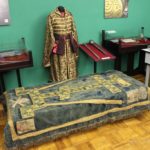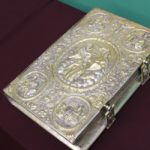24 March 2023 , in Chernihiv Historical Museum named after VV. Tarnovsky, on the occasion of the 400th anniversary of the granting of Magdeburg law to Chernihiv, a round table was held and an exhibition was opened.
The emergence of self-government in Chernihiv dates back to the 17th century. Саме 400 років тому, 27 March 1623 year, the Polish king Sigismund III granted a privilege to Magdeburg law (municipality) Chernihiv.
Legal relations of city self-government arose in Germany during the Middle Ages, in the twelfth century. They were first started in the city of Magdeburg. Magdeburg law appeared on Ukrainian lands in the 13th–14th centuries., in Chernihiv Oblast - in the 17th century. So, He received it from Lviv 1356 year, Kyiv in 1494 year, Chernihiv - 1623 year.
As a result of the Polish-Moscow war (1609– 1618) lands of Chernihiv-Sivershchyna in 1618 became part of the Polish-Lithuanian Commonwealth. Striving to spread and consolidate its influence in new territories, Poland transferred the rules of the organization of power here, stealing, traditions in socio-economic relations.
Cities, where a significant amount of the population was concentrated, production capacity, sales markets, financial opportunities, received a system of self-government - an apparatus for managing the life of cities, which was formed by citizens on the basis of electability, was based on urban economy, accumulation and distribution of the budget, own judiciary, social security, symbols. Workshops are corporations of craftsmen, were one of the features of Magdeburg law. The main governing body of the city was a magistrate headed by a viit. The first viit of Chernihiv was the nobleman Yan Kunovskyi.
In the privilege of King Sigismund III, among other things, the city coat of arms of Chernihiv was approved - St. Vladyslav in knightly armor with a red banner. The administrator of the Chernigov-Siver region at that time was Prince Vladyslav, the future king Vladislav IV, and St. Vladislav was his patron. Image of St. Vladyslav existed on the city seal of Chernihiv from 1623 to 1782 Dr.. The figure of St. Vladyslav remained on the city seal until 1782 р., when another city coat of arms was approved by decree of Catherine II - a black eagle under a crown with a cross in its paw (at the same time, Chernihiv was also deprived of self-government).
Chernihiv had its own flag: “The magistrate of Chernihiv has, a special magistrate's banner, which is used in common with guilds in ceremonial exits, triangular, and consists of a blue damask. On one side is an image of the Transfiguration of the Lord; on the sides of this image on the right - the prophet Moses, and on the left the prophet Elijah, at the foot of the onago the Holy Apostle John, Apostle Peter and Apostle James; on the other side is the former magistrate's coat of arms. Border of onago banner of yellow damask, along the edges of which, instead of a gimp, gold and silver leaf stripes and trimmed with silk lace”.

Specialists in the history of Chernihiv and Chernihiv region of the 16th–18th centuries joined the round table.: doctors of historical sciences Petro Kulakovskyi and Serhii Lepyavko, candidates of historical sciences - Hanna Domanova, Igor Sity, Olga Geyda, Yuriy Sity and Iryna Petrychenko.
Presented at the exhibition 13 original exhibits of the 16th - early 20th centuries. з музейної колекції. Mainly, these are documents that illustrate the manifestations and peculiarities of Magdeburg law in Chernihiv and on the territory of Chernihiv-Sivershchyna. Namely,, legislative acts, collections of documents, workshop books, historical works, печатка, tokens. The deed of Prince Vladyslav to the son of the boyar Yakov Boroznin on land is unique, dated February 1623 year, with Vladyslav's autograph and his seal.



















More Stories
Congratulations to dear Vera Zaychenko!
Anthem of Ukraine and Verbytskyi
Commemoration of the liquidators of the consequences of the accident at the Chernobyl nuclear power plant